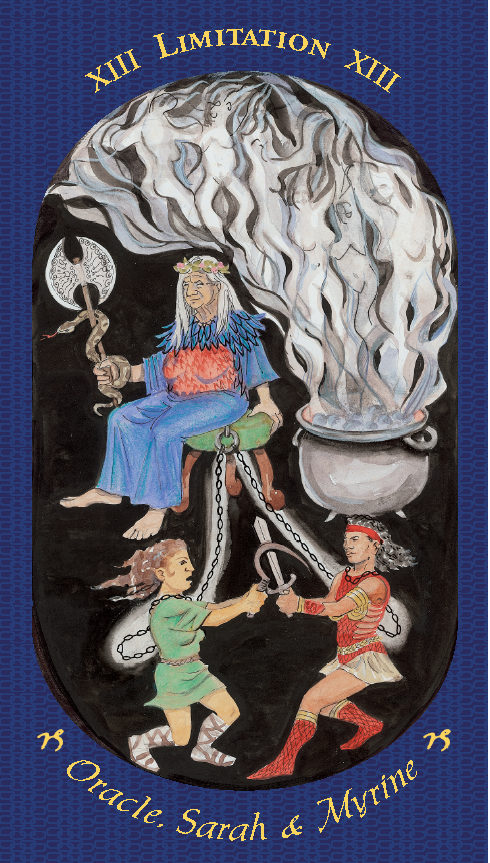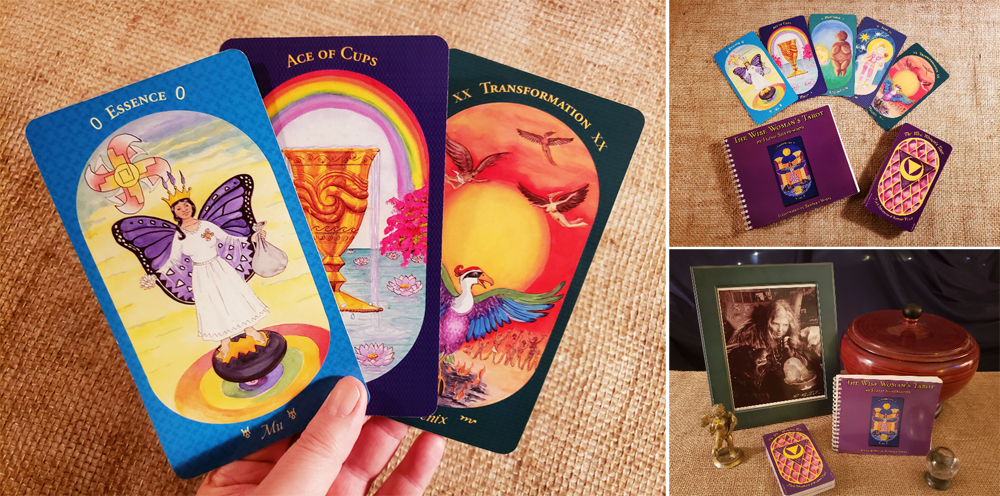
KEYWORDS: Blockage, negativity, limited thinking, frustration.
The card of Limitation represents the point in time when beings no longer enjoyed the easy flow between levels of consciousness, from spirit to matter. Because they ceased seeing all as divine, they weakened their own link to the Goddess, becoming stuck in a material existence. In other words, by viewing those they deemed inferior as being separate from the All, they affirmed separation, thereby losing contact with wholeness.
If all were not of a Goddess/God essence, then the next step would be to create an intermediary, like the Hierophant in traditional decks to bridge the sacred and mundane worlds, and to reach those who had become estranged from their direct link to the Source. I removed the Hierophant combining it instead with the Devil to create this card of Limitation, showing how intermediaries limit our experience of the Divine.
Once this intermediary was enthroned, it encouraged those beings to seek Divinity outside themselves, truly enslaving them to a limited consciousness. This card is the antithesis of the Lovers/Wholeness card. Where there is a free-flowing channel for energy, that energy stays in a positive mode; when it is blocked, we find driven, compulsive people.
The biblical allegory of “the Fall” is an aberration of the truth, at best. According to Judeo-ChristianIslamic theology, “God” created all that is good and wonderful while “man” must take responsibility for all that is evil. To cope with this overwhelming task, a scapegoat had to be found to assume the burden for man’s “sins” – hence the creation of the Devil.
The most common image of the Devil is modeled after the pagan goat-footed (scapegoat!) God of sensuality, Pan. Christian dogma deplored Pan’s life-affirming unbridled affirmation of sexuality. Beyond procreation, sexual impulses were deemed sinful and thus were projected on – who else? – the Devil. In addition, anything unexplainable or beyond human comprehension [deemed negative] was considered the work of the Devil; those who probed the unknown were ‘in league with the Devil.’ Around the world, the ancient Gods and Goddesses became the devils to the conquering new patriarchal order. Even the word “devil” is derived from the Indo-European word “devi,” meaning Goddess.
As beings affirmed separateness rather than unity, the need for scapegoats and intermediaries arose. As long as people looked outside themselves to discover their divine essence, they were limited by and subject to the religious dogma of their cultural setting. The externalization of the deity lays the cornerstone for the oppression of all who are deemed “other” by the prevailing system. When all beings truly recognize their own divinity, no priest or politician can demand subservience. After all, who can pull rank on a Goddess or God?
According to Madame Blavatsky in her masterwork, The Secret Doctrine, “God is light and Satan is the necessary darkness or shadow to set it off, without which pure light would be invisible and incomprehensible.” Claiming our shadow now becomes our path to enlightenment.
When we project our negative feelings or shadow side on another, we constellate the scapegoat. This scapegoat takes away our “sins” and robs us of our ability to free ourselves. The disowning of our shadow is a binding limitation as it denies us insight needed to release outworn behaviors which hold us back. The powerlessness one feels at this point can snowball into a myriad of negative thought-forms, creating a stalemate or a place of no action. Frustration can lead to anger which can lead to violence.
We must learn to break this chain. As long as we look outside ourselves for deliverance or to allot blame, we collaborate in the maintenance of our repression and frustration; we limit our ability to move forward.
In the center of this card, we see the Oracle, the ancient intermediary, at her shrine at Delphi. Delphi, “the womb,” was in fact the site of the oldest, most famous oracular shrines to the earth mother, Gaia. Gaia was worshipped through her priestesses known as Delphyne.
The Oracle, wearing blue-bird robes, is seated upon a tripod stool, with Python, her oracular serpent, coiled around her labyris sceptre. After a person becomes immunized, the effect of a snake’s bite (especially the cobra’s) can put one into a trance-like hallucinogenic state; perhaps this priestess was actually bitten by her “familiar” to invoke prophecies.
Her head is adorned with a wreath of cherry laurel. The Pythoness, as she was also called, chewed the leaves to induce her prophetic trances. The cherry laurel contains traces of cyanide, which can cause delirium and foaming at the mouth, both of which were reputed symptoms of the oracle’s divine possession. The Oracle is shown here as an old woman with flowing white hair, her face marked by lines betokening wisdom. Her breast and midriff show feathers symbolizing her vulnerability around the solar plexus and heart chakras. She is staring into a steaming, bubbling cauldron as vapors envelop and almost shroud the ethereal beings dancing in wild abandon above her head – the free souls that once graced this planet.
Chained to the throne of the Oracle are the matriarch from Major Arcana card X – the Healer, and the Amazon from card XI. They raise swords at each other; they have forgotten that they are of one Source, and they now see each other as the “scapegoats” for their own imperfections. They, like other beings, have bonded to the notion that they must go outside themselves, through an intermediary, to reach their divine essence. The chains about their necks are loose; so they can in fact free themselves whenever they choose. But the source of their liberation is hidden in the black background indicating the absence of light.
When this card emerges in your spread, don’t turn to others; look inside for your own divine guidance. Do not fear the frustrated feelings that this card evokes, they can lead you on a path back to your center to truly grapple with the shadow side of your nature. The positive side of this card generally unfolds only after we run into the same wall for the 99th time, and finally “get it.”
To the extent that we love our familiar chains, to that extent we suffer the pain of limitation. When beset by these feelings of bondage and frustration, look toward a light at the end of the tunnel, and go toward it.



